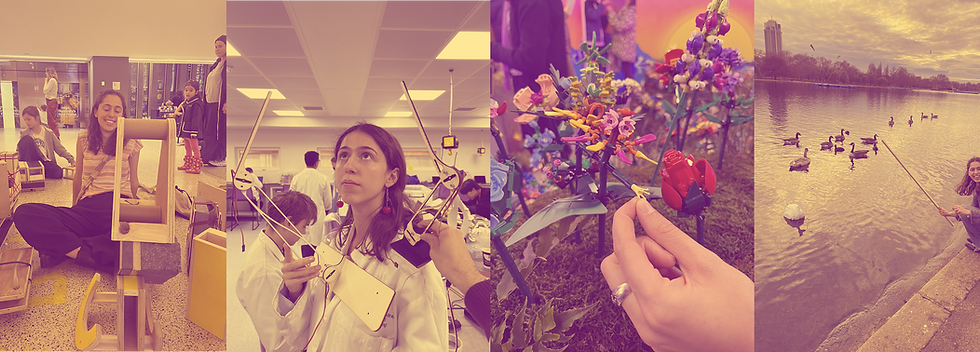
Nice to meet you - I'm Maggie
In Short
I’m a curious and fearless UX researcher and designer. I believe every interaction with technology, including toys, must be designed with care because it shapes how we live, behave, and see the world. Play is foundational to my practice. Take a look at some of my projects below!
Interested in Play, and How We Should Shape its Evolution
e2 Young Engineers West London: Lead Instructor
At Young Engineers, where I facilitated events and summer camps, I explored how traditional toys and modern motorised mechanisms can work together while preserving what I see as the essential benefits of play: fostering divergent thinking, curiosity, awe...
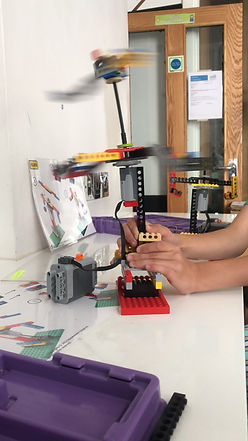

....and mischief!

let the sound of motors sooth you as you hear the kids discuss their models - a sign of success for me!
I discovered that children will engage in a learning experience if it helps them bring an idea to life. Hence, appealing to the imagination is essential when designing a game/toy. In my workshops, trivialised explanations of gears, force, and torque, even Newton's second law, lent themselves to the design of the fastest conveyor belts and carrousels, or ultra-far-reaching crossbow projectiles.



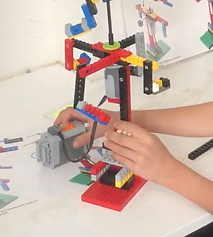
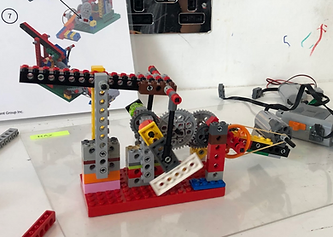

Passionate about Diversifying Modes of Interaction with Technology, and Fascinated by Sound
Sound Moves: 3D audio-driven interactions for mobile games
Sound Moves is an investigation into 3D sound-driven audio gaming, supported by the Royal National Institute of Blind People (RNIB). Sound is traditionally a secondary element in interaction design, used mainly for feedback, notifications, progress tracking, and to support visuals in creating mood, tone, and immersion. As modern interfaces become more diverse and context-sensitive, sound is bound to gain new relevance.
Exploration: how does sound shape the way we move? Series of games and workshops using sound a driver of interaction

custom-made buzzwire game with varied sonifications: here, a gyroscope detects rotation of the handle, which is sonified. how does sound impact our fine motor skills?

arcade game design workshop: what could a sound-driven arcade game be?

study of impact of sound design on location tracking of multiple sources
Could we interact with a sound based interface?

sound Interface: could users use a 3D sound menu?
Some Key Insights
- Sound perception (psychoacoustics) is governed by totally different laws than sight - it is omnidirectional, enables full mobility, is resolved much better horizontally than vertically, and has its own kinds of 'deaf spots'. This presents opportunities to design powerful immersive and mobile gaming experiences.
- We very often use a combination of sight and sound to identify a sound source's location, which makes interaction with sound without visual cues difficult.
- Interacting with sound in space without any visual complementary cues is not common and therefore could be at the core of an intriguing and novel gaming experiences.
- We localise sound by moving our head and perceiving how what we hear changes. I therefore need to incorporate head tracking into my game mode.
Final Concept: Interaction with 3D Sound Objects in Audio Mobile Games
In gaming, sound being the primary driver of interaction, makes sense. It encourages us to pay attention to the subtleties of a medium ideally suited for storytelling, immersion, and emotional engagement. It also serves the 100 million visually impaired gamers in the UK alone, who are rarely fully included in the design of games.
Interaction with 3D audio is underexplored in current mobile audio games, so I designed a new mode and types of interactions, which allow the player to interact with sound objects in an anchored 3D sound space. The concept was tested by Ben Breen, Lead Game Accessibility Consultant at the Royal National Institute of Blind People, who is now on board to support all further testing and developement.
The Experience
The Tech

Possibility for interaction with an anchored comprehensive soundscape: Tech ecosystem for embodied mobile interactions: head tracking through CoreMotion framework and gesture recognition through a custom AR app - the phone is used as a remote control/laser pointer. Audio Spatialisation through Steam Audio for Unity.
The Interaction Toolkit

INVENTORY: Could we memorise a sound inventory better if it were spatialised?
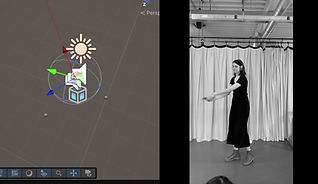
WEAPONS AND WEAPON SWIPING METHOD: How fun could sound weapons be if their audio feedback was spatialised?
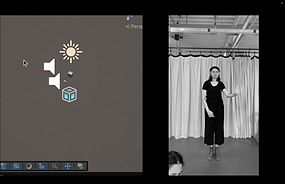
PROGRESS BAR: spatialising a single frequency or sound element of an add/character dialogue to let the player know how much they need to wait

MOVING SOUND: localising, grabbing and moving sound mechanics
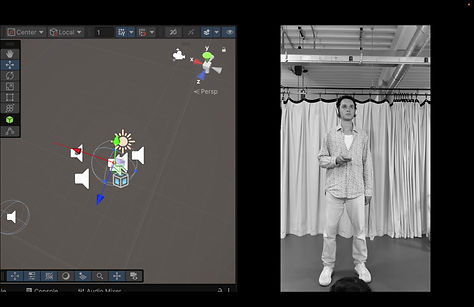
THROWING SOUND: throwing mechanics and feedback
Demo: 2 Audio Games
With the most successful interactions of the toolkit, I designed two games. Here are their recordings! The Audio will not be spatialised properly for you, because it is recorded from the point-of-view of the player. Note that they never look at a screen - they orient themselves using sound only!
GrowlAttack: Classic zombie shooter with 4 different levels

Shush: RPG where the player needs to find their 'magazines' in their sleeping baby sibling's room without waking it up. The player needs to interact with the 'good' and 'bad' fairies of slumber, who are trying to sabotage the player's mission.
An Interaction Designer and Mixed Methods Researcher
In&Out Design: Phygital Collaborative Mapping Method
Highest grade in the cohort for prototyping. Selected to present prototyping journey to junior cohort.
The Problem
Volunteering at East London Waterworks Park - a charity aiming to convert an abandoned Thames Water water treamtment station into a swimming area, park, and community space - I realised how complicated carrying out landscape codesign workshops could be.
Indeed, participants will be collaboratively mapping layouts on a 2D sheet of paper, often with very poor immersion of the space and understanding of the scale, which in turn impacts the number of ideas, iterations, and the confidence of participants about their contribution. Moreover, records of these codesign workshops and often lo-fi and hard to hand over or use as a communication piece.
So I wondered - could we use digital immersion as a simple way to restore immersion and understanding of scale during landscape codesign workshops?
Observational Study
I selected 3 groups of 3 people and made them work on the same spatial design project, but on 3 different platforms with different levels of immersion. I witnessed, recorded, and transcribed the dialogue. Wordings that are proxies to 'productive communication' were highlighted and counted. Participants' confidence levels were also surveyed after completion of the workshop.

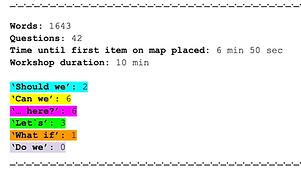

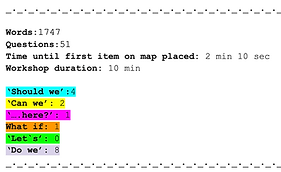


Key insight: The more participants are immersed in a digital twin of the space, the better they understand the space and its scale, but the less they communicate with each other and build on each other's ideas.
The Solution: In&Out Design

In&Out Design is a physical and digital design experience allowing participants of collaborative mapping workshops to visualise their maps digitally in real-time, without having any 3D modelling skills or budget. The mapping remains physical as a way for the mapping experience to remain human, rich in conversation and debate.
Elements on the physical map are added in the shape of pawns with unique identifiers at their top. After the mapping is complete, a picture of the top-view of the map is added and uploaded to a program, which recognises the pawns and their placement and sends the right coordinates to the 3D engine which can create a 3D model of the park in seconds.
Validation:
Hypothesis: Higher immersion changes the feeling of a space

What's the feel of this room? 2D, then 3D. Do you change your mind? (results quantified, 30% people changed their minds)
Hypothesis: Higher immersion makes understanding of scale greater

Draw garden furniture at scale on Figma. Then see them in 3D, then amend your drawing if needed (improvements quantified, 100% of changes made drawings more accurate)
Conclusion: Yes, immersion gives a new impression of the space through an enhanced understanding of layout and scale.
Crafting Strong Rationales For Product Developement Decision Making
CARDI: a sofa design for appropriate durability
In this 5-week project for a major UK sofa company, our team had to assess products and supply chains to identify the negative externalities of the brand's linear economy model. We also had to identify commercially viable opportunity for design with better material circularity.
The following are some slides of our team's final presentation to the brand.
(confidential information redacted)

##%
##%
Brand

#
#%
#%
#%


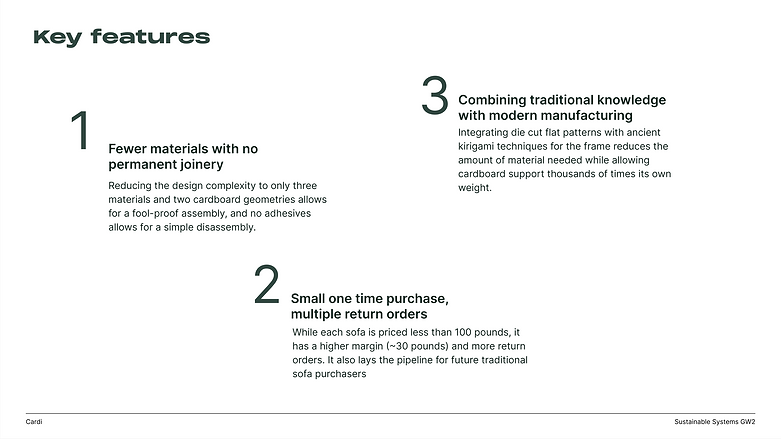
Thank you!
I hope to meet you soon! In the meantime, please feel free to take a look at some of my other projects